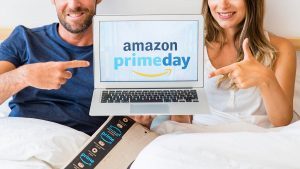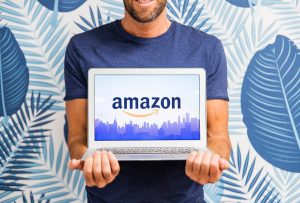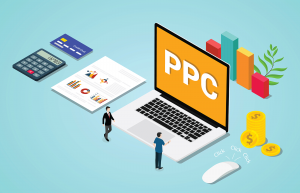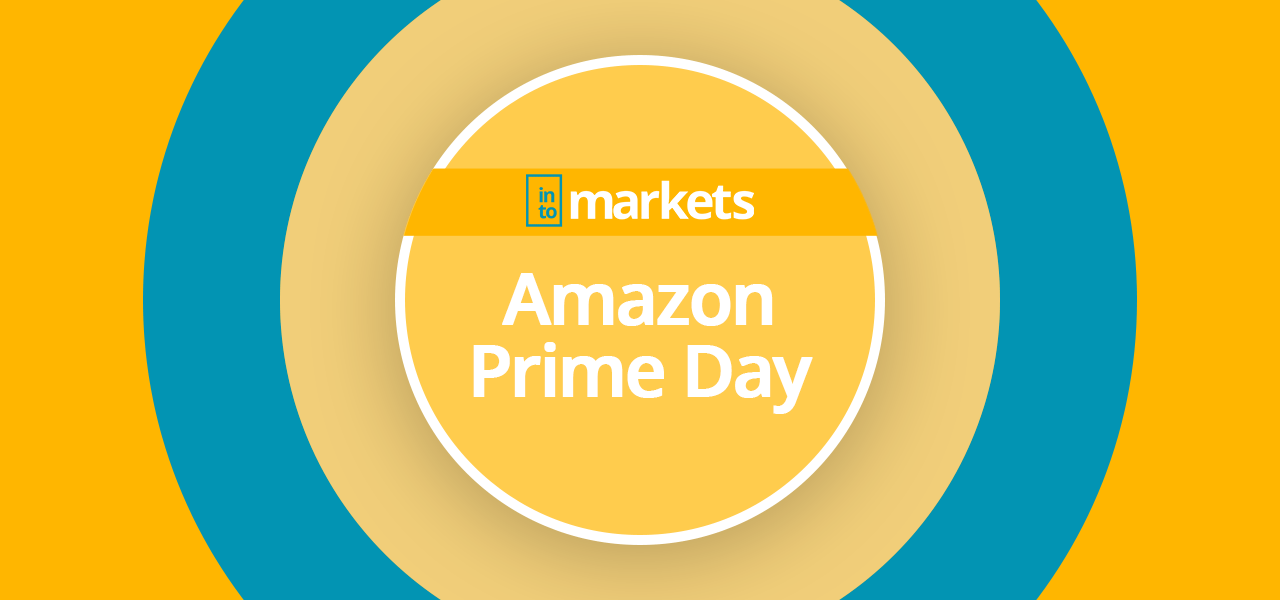What Is Prime Day?
There are essentially two critical milestones from a dealer and buyer perspective when talking about the Amazon marketplace: Prime Day and Cyber week together with Black Friday. The latter traditionally takes place at the end of the year just before Christmas, when people get excited about the annual shopping and gift rush. Prime Day is as influential and important shopping event as cyber-week, Amazon launches it mid-summer every year. The platform advertises the event weeks in advance on all channels as one of the most important e-commerce events in Europe and the USA. On Amazon´s homepage there are a wide range of products, some of which have been greatly reduced especially for Prime Day and are only available for a limited time. The platform pushes especially its own branded products, such as “Amazon Basics” and “Amazon Echo” during the shopping event.
Prime Day relevance for Sellers and Vendors
 From a consumer perspective, this global shopping event is hugely significant, since buyers can get their favorite products and brands at a much lower price. This worldwide event is perhaps even more relevant for the retailers, brands, and suppliers considering that Amazon advertises Prime Day massively via all online and offline channels, even more, buyers are flocking to the platform currently. Amazon is mainly targeting existing and new prime customers. Because they are not only generally more active than non-prime customers, but also spend on average three times more money on online shopping. From a B2B perspective, two factors are particularly beneficial for Prime Day: higher traffic and greater willingness to buy. Many sellers, therefore, record significantly higher sales figures every year at Prime day, which can even have a more lasting effect than just the temporary increase in turnover. It is essential to prepare well for this event as a seller or vendor- the important concepts here are retail readiness, PPC, and display campaigns.
From a consumer perspective, this global shopping event is hugely significant, since buyers can get their favorite products and brands at a much lower price. This worldwide event is perhaps even more relevant for the retailers, brands, and suppliers considering that Amazon advertises Prime Day massively via all online and offline channels, even more, buyers are flocking to the platform currently. Amazon is mainly targeting existing and new prime customers. Because they are not only generally more active than non-prime customers, but also spend on average three times more money on online shopping. From a B2B perspective, two factors are particularly beneficial for Prime Day: higher traffic and greater willingness to buy. Many sellers, therefore, record significantly higher sales figures every year at Prime day, which can even have a more lasting effect than just the temporary increase in turnover. It is essential to prepare well for this event as a seller or vendor- the important concepts here are retail readiness, PPC, and display campaigns.
Preparation for Amazon Prime Day
Visitors and buyers alike need above all one thing: enough goods in stock. As part of the preparations for Prime Day, Amazon typically orders more units in advance from vendors of well-running and profitable products. Suppliers and manufacturers should, therefore, clarify a few weeks before Prime Day whether supplies can still be ordered and delivered at short notice. The same applies to sellers, regardless of whether they are set up via FBA or FBM. Anyone who handles their fulfillment via Amazon should send goods to the Amazon logistics centers on time before the event begins because the warehouses around this shopping time are more frequented and bottlenecks can occur shortly before the event due to a lack of space in the warehouse or delivery problems. Moreover, “Out of stock” is an absolute no-go, especially at shopping events like Prime Day and Cyber week.
In addition to the logistics component, it should also be noted that although Prime Day will only take place on two specific days, from the seller’s point of view, the event is more likely to be integrated into three significantly longer phases:
Prime Day Lead-In Phase
Due to the massive media presence on all channels in the daily life of consumers, Amazon generates enormous visibility for Prime Day and brand awareness among consumers. Everyone is curious about which products are discounted and when the first bargains will be available. As a result, traffic on the marketplace is expected to be significantly higher as early as two weeks before Prime Day. In this so-called “lead-in phase,” smart marketing can already draw initial attention to the company’s products.
Prime Day(s)
During the two Prime Days, Amazon expects a stronger user activity leading to more sales. Each additional sale achieved during those days increases the bestseller ranking (BSR) indirectly affecting the organic keyword ranking and the sales opportunity of the PPC campaigns.
Prime Day Lead-Out Phase
Even if the traffic drops quickly again directly after Prime Day and levels up to an average level, it should nevertheless be noted that in the approximately two-week lead-out phase there is still an increased probability of a sale. PPC campaigns and above all retargeting measures should, therefore, continue intensively within the two weeks following Prime Day.
Amazon Prime Day Statistics
To understand a bit better what Prime Day means for Amazon and its buyers a seller, you must look at a few statistics. Here only a few, but quite impressive numbers:
- Prime Day takes place in 17 countries worldwide on the same days
- In 2018, Prime Day generated a total turnover of 1.5 billion US dollars.
- One million Fire TV sets were sold on Prime Day 2018.
- Amazon in the USA sold a total of 1 million smart home devices on Prime Day in 2018.
- In 2018, with one million Prime Day Deals, Amazon generated a total of 100 million sales worldwide.
Every year Amazon has managed to make Prime Day more and more globally known and popular with consumers. In addition to pure discount shopping, Prime Day has now also become an entertainment event with concerts and special events. The question quickly arises:
Is Prime Day worth it for Amazon?
 In a nutshell: Absolutely! At this point, we would like to briefly point out the basic concept of the marketplace and the associated Amazon Flywheel, which also explains why Amazon is so successful. The more buyers on the platform that interacts with the “Amazon” brand, the more sellers and thus more products and offers the platform attracts. With its reach and the enormously high commitment rate of Prime customers, Prime Day fires exactly this basic concept, this, in turn, means that more and more consumers are becoming active in the Amazon ecosystem and spending their money on online shopping in the short, medium and long term here and less and less elsewhere. For sellers and vendors, is curse and blessing at the same time because on the one hand the turnover on Prime Day can be increased significantly with the right strategy, suitable products, and attractive offers, but on the other side from a B2B point of view, one becomes more dependent on only one sales channel. With the right preparation, allocation of advertising budget, and selection of the right products, e.g., for quick offers and manual discounts, Prime Day can be better used from the dealer’s point of view.
In a nutshell: Absolutely! At this point, we would like to briefly point out the basic concept of the marketplace and the associated Amazon Flywheel, which also explains why Amazon is so successful. The more buyers on the platform that interacts with the “Amazon” brand, the more sellers and thus more products and offers the platform attracts. With its reach and the enormously high commitment rate of Prime customers, Prime Day fires exactly this basic concept, this, in turn, means that more and more consumers are becoming active in the Amazon ecosystem and spending their money on online shopping in the short, medium and long term here and less and less elsewhere. For sellers and vendors, is curse and blessing at the same time because on the one hand the turnover on Prime Day can be increased significantly with the right strategy, suitable products, and attractive offers, but on the other side from a B2B point of view, one becomes more dependent on only one sales channel. With the right preparation, allocation of advertising budget, and selection of the right products, e.g., for quick offers and manual discounts, Prime Day can be better used from the dealer’s point of view.
Product and campaign optimization for Prime Day
At this point, it is essential to understand the possibilities and differences between sellers and vendors, how and what exactly you can do to prepare for Prime Day. Vendors, i.e., suppliers for Amazon (e.g., manufacturers, brands, distributors), cannot quickly lower the prices of their products. Here, exclusive Prime Day deals can only be made with the approval of the Amazon Vendor Manager, for example. In return, these offers often end up on the corresponding deal pages that Amazon sets up for Prime Day. Sellers, on the other hand, can adjust the selling prices of their products for Prime Day as they wish and determine for themselves which products and in what quantities they generally want to offer on the marketplace. The aspect that is the same for both is that they must take timely action about Amazon SEO and Amazon Advertising. Even if the buyers move a lot on the dedicated deal page, especially on Prime Day, the traffic on the platform is still higher than on “normal” days, and therefore the customers will probably add something to their shopping cart beyond the prime day deals, this presupposes an excellent visibility of the own product portfolio.
Optimize Amazon products for Prime Day
The basis of all activities on the Amazon platform is well-optimized products. Sales-promoting images, meaningful titles, keyword-optimized bullet points, and descriptions are among the absolute basics and are also the basis for whether and how well the performance marketing campaigns will run later. Not to be underestimated is the time factor that is required for excellent and comprehensive product optimization, especially for more extensive portfolios. For this reason, the preparations for Prime Day should start at the right time and, above all, in a structured manner. It is important to note that it takes a little time until all Amazon keywords available in the ASIN listing are indexed and can make excellent positions within the SERP. It is also essential not only to look at Amazon’s A9 algorithm during optimization. Ultimately, real people buy the products, and a collection does not convince them of keywords. The right approach to the target group, as well as essential characteristics of the products, should be present on every product detail page. As a specialized Amazon SEO agency, we know that many sellers and vendors often find it difficult to proceed in a structured and time-sensitive manner, especially with many articles.
Preparing Amazon PPC campaigns for Prime Day
 Especially on Prime Day, measures in performance marketing on Amazon are enormously necessary. Anyone who has miscalculated here or only set up rough car campaign structures is very likely to give away enormous amounts of potential and thus also money. Since on Prime Day, the traffic on the Amazon marketplace is much higher than on average days; the PPC-based advertising campaigns tend to be clicked on more frequently. Therefore, it is crucial to increase the daily budget in time temporarily and to increase the bids on the keywords accordingly, so that you continue to win the auctions against your competitors and remain visible. In our experience, the actual costs of the click prices (CPC) on Prime Day are not exorbitantly higher but increase only slightly and often only by a few cents. However, with an above-average higher click rate and a prime-day-typically higher conversation rate (CVR), the revenue-cost ratio (ACoS, or ROAS) improves above average with only a slight increase in CPCs. In the end, this means that with every Euro marketing budget invested in PPC, significantly more sales are generated on Prime Day. Alternatively, to put it another way: Costs increase slightly, sales increase sharply. It is therefore worth taking a closer look at the campaigns in good time before Prime Day and readjusting them if necessary. The consequences must be considered:
Especially on Prime Day, measures in performance marketing on Amazon are enormously necessary. Anyone who has miscalculated here or only set up rough car campaign structures is very likely to give away enormous amounts of potential and thus also money. Since on Prime Day, the traffic on the Amazon marketplace is much higher than on average days; the PPC-based advertising campaigns tend to be clicked on more frequently. Therefore, it is crucial to increase the daily budget in time temporarily and to increase the bids on the keywords accordingly, so that you continue to win the auctions against your competitors and remain visible. In our experience, the actual costs of the click prices (CPC) on Prime Day are not exorbitantly higher but increase only slightly and often only by a few cents. However, with an above-average higher click rate and a prime-day-typically higher conversation rate (CVR), the revenue-cost ratio (ACoS, or ROAS) improves above average with only a slight increase in CPCs. In the end, this means that with every Euro marketing budget invested in PPC, significantly more sales are generated on Prime Day. Alternatively, to put it another way: Costs increase slightly, sales increase sharply. It is therefore worth taking a closer look at the campaigns in good time before Prime Day and readjusting them if necessary. The consequences must be considered:
- Amazon must manually approve sponsored brands. Therefore, they should be created and released a few days in advance (if possible) so that they can be played on Prime Day at all.
- Bestsellers who already perform with ethical ACoS values should get special attention on Prime Day: More budget and higher bids should be planned.
- Evaluate historical values from last year’s prime day in good time and apply learnings to current campaigns (e.g., which categories sold particularly well).
- Target competitors with sponsored products and product-attributed targeting on Prime Day. Think of self-protection campaigns with the same advertising medium.
- Set up unique prime-day PPC campaigns for sponsored products and provide them with separate budgets. Please only add TOP products here.
- Sharply increase budgets for well-running car campaigns to secure maximum playout probability on the competitor product side, among other things.
- After Prime Day, download and archive keyword and ASIN report so that they can be used for Prime Day next year.
Preparing Amazon DSP for Prime Day
As an Amazon dealer, you can and should carry out measures for Prime Day not only in high-turnover PPC marketing. A customer’s purchase decision often begins much earlier and is then only “executed” on the Amazon marketplace. Amazon DSP can and should also be used for Prime Day using broad display campaigns and well-thought-out targeting of suitable target groups. The Programmatic Advertising enables many websites outside of Amazon to be fired up with advertisements for their products and thus encourage customers to buy before they search the marketplace. However, it should be noted that the budgets for Amazon DSP should be allocated much higher than for PPC campaigns since display campaigns are not billed per click, but per 1,000 impressions (CPM or CPP model). This means that, in case of doubt, a very high impression rate but a weaker click rate must be expected. It is better to focus on retargeting campaigns for Prime Day and the next two weeks afterward. So, if you manage to increase the traffic to your products significantly through well-optimized listings and effective PPC campaigns, you will also increase the “pool” of potential later buyers who can then convert to buyers via retargeting measures. Alternatively, to put it another way: the higher the organic and inorganic traffic on Amazon itself, the more starting points and data one has later for retargeting campaigns via Amazon DSP. Since the traffic increases significantly on Prime Day, this type of downstream advertising can and should also be considered.
Criticism of Amazon Prime Day
 Where there is so much hype about one or two hot sales days, there are, of course, also critical voices. On the one hand, it’s all about the “Amazon system” in general (i.e., fair wages, counterfeit products, exploitation by big American companies, etc.). On the other hand, there is also direct criticism of Prime Day itself. For example, the world reports that consumer protectors are warning against Prime Day. In this context, there is the talk of “sales-psychological torture instruments” such as expiring countdown timers and artificial shortages. That such measures, however, are not an invention of Amazon itself but have already been used in e-commerce for over ten years on other well-known platforms such as eBay, Otto, Zalando or many different online shops, often goes unmentioned. The choice of words “instrument of torture” also clearly reveals subjective intentions and unfounded opinions. The criticism on Prime Day that not every advertised special offer is a real advantage for the consumer is undoubtedly justified, even if it is not reduced to Amazon alone.
Where there is so much hype about one or two hot sales days, there are, of course, also critical voices. On the one hand, it’s all about the “Amazon system” in general (i.e., fair wages, counterfeit products, exploitation by big American companies, etc.). On the other hand, there is also direct criticism of Prime Day itself. For example, the world reports that consumer protectors are warning against Prime Day. In this context, there is the talk of “sales-psychological torture instruments” such as expiring countdown timers and artificial shortages. That such measures, however, are not an invention of Amazon itself but have already been used in e-commerce for over ten years on other well-known platforms such as eBay, Otto, Zalando or many different online shops, often goes unmentioned. The choice of words “instrument of torture” also clearly reveals subjective intentions and unfounded opinions. The criticism on Prime Day that not every advertised special offer is a real advantage for the consumer is undoubtedly justified, even if it is not reduced to Amazon alone.
Similar sales-promoting and sometimes not entirely customer-friendly methods are also used in Alibaba’s “Singles Day,” for example, which generates even more sales. From our point of view, consumers themselves are always asked to compare prices and question excessively reduced offers. An excellent way to check Prime Day deals for a real bargain is the small and free chrome browser plugin “Keepa, which displays a price development next to each product after installation. So, if special Prime Day prices are artificially raised shortly before, only to sell them later as apparent discount promotions, this can be visualized very transparently with “Keepa.”
Conclusion: Is Prime Day worth it?
In short: Yes, Prime Day is worthwhile and generates a kind of “win-win-win” situation:
- Amazon wins new Prime customers during this time and generally creates a higher reach for itself and its dealers. Also, Amazons itself will profit directly on Prime Day.
- Sellers and vendors can increase their sales and turnover enormously over a period of four weeks (2 weeks lead-in + 2 weeks lead-out) and of course on Prime Day itself and generate new customers for themselves.
- Buyers have every year the chance to get direct and indirect prime day discounts.
From a retailer’s point of view, it is, of course, important not to forget the profitability of the promotions because of the increase in turnover and sales. Not every Euro invested in advertising and discounts is worthwhile and should be calculated well. If certain products in some categories are already bestsellers anyway and rank very well organically, then even well-placed deals on Prime Day can hardly improve this. In addition to profitability, there is also the counter-argument of the market share, i.e., every product of a brand purchased by the buyer is very likely not purchased from another brand (or another retailer). So, if the strategy is to gain market share or displace other brands, then unprofitable sales can also pay off. Moreover, one thing is undisputedly sure: If you can achieve one on Prime Day, then it’s sales.




